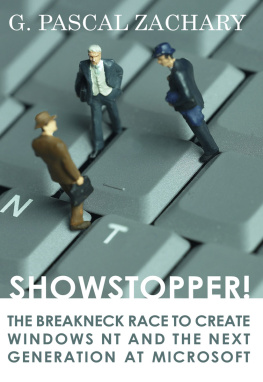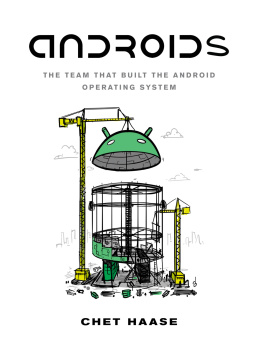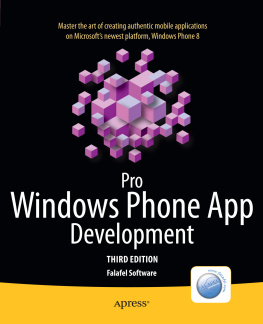Copyright 1994 by G. Pascal Zachary.
Published by E-Reads.
All rights reserved.
Excerpt from I Want a Little Sugar in My Bowl, by Nina Simone, copyright 1962 and 1990 by Sam Fox Publishing Co., Inc. Santa Barbara, CA. All rights reserved. Used by permission.
INTRODUCTION
David N. Cutler, wearing white Reeboks, white pants and a T-shirt bearing the legend OVER THE LINE, bursts into the Build Lab and takes stock of the largest, most complex program ever created for a personal computer.
It is 10:20 in the morning, and the latest build of the program, called Windows NT, is hours late. Cutler, the leader of the team making NT, is angry about the delay, angry about a botched test the day before, angry at the world. He knows that nothing slows progress more than a steady accumulation of small lapses, and he is bent on pushing ahead.
Cutler insists on frequent builds, or samples, of NT so that his 250 programmers can eat their own dog food. It is a frustrating experience, not unlike building a house from scratch while living in it. The sooner a build arrives, the sooner his team will test their latest creation, discover its imperfections and improve it.
Scowling, Cutler now slumps into a swivel chair and glares at the computer screen before him. He hits a few keys and groans.
Cutlers unhappiness is contagious. Three builders, who stitch together NT with the aid of computers, hover behind Cutler, busying themselves while Cutler churns. One, a shoeless and jittery young man, juggles three rubber balls. He is surrounded by dozens of computers. The voice of Aretha Franklin, romping through Dr. Feelgood, fills the room from the stereo speakers mounted on the wall.
No fan of juggling or Aretha, Cutler growls. He jumps to his feet, flinging the chair behind him, and storms out of the lab. The shoeless juggler and the chief builder dip into a big jar of Rolaids, popping one each. The day has soured early.
Minutes later, Cutler returns to the Build Lab even more upset. His bowlegged gait and burly arms remind people of Popeye. Youre wasting the whole goddamn morning not having this goddamn thing ready, he snaps. Then, sounding dejected, he tells the juggler, Call me if you ever get this [build] out today.
His face reddening even more, Cutler leaves again, steaming. His rough creed forbids him from containing his emotions. The way you let off stress is to let it out, he says. He isnt too particular about how he does it. A circle drawn on the wall near the door marks the spot where he once unleashed a violent kick, cracking his toe. Just the other day, he smashed a wall with his fist, which ordinarily would not have caused a stir except that this time he hit a stud and broke a finger.
Cutlers impatience is ill mannered but understandable. Time means everything to him now. He is a year behind schedule, and after years of work his team is tired and frustrated. Only the enormity of their goal sustains them now. The 250 members of the team aim to produce a computer program so powerful and versatile that someday everyone will need it. Standing in their way are thousands of bugs, or coding errors, and persistent doubts about the basic design of NT, which stands for New Technology.
Rather than a single entity, NT consists of scores of intertwined programs that together comprise an operating system. This software turns a personal computer into a precise tool of thought, helping a person or an organization control its most valuable asset: information. NT exerts its power through a dizzying succession of ordinary actions. Seemingly at once, it may open a computer file, move text or graphics from one place to another on a screen, print a letter, calculate a row of numbers and keep several word processors, spreadsheets and other applications from getting in each others way. NTs most profound benefits are hidden. Its invisible acts sustain a computer much as unconscious actstaking a breath, blinking an eye, hearing a soundsustain a human life.
NT is alarmingly complex. Consisting of six million lines of code, the program is among humanitys most intricate handiworks. No one mind can comprehend it all, Cutler says.
A system as complicated as NT requires a rich patron. In William H. Gates, NT has one of the richest. Gates is cofounder and chief executive of Microsoft Corp., the worlds largest software maker. With NT, Gates seeks to extend his software dominion from desktop software, which he monopolizes, to the network. In the 1980s, Microsofts DOS and Windows system software defined the way most people worked with computers. In the 1990s, the company aims to define the software that electronically ties together workers and businesses, consumers and homes. The making of NT, Gates hopes, will be the first step toward realizing this grand dream.
Gates also intends to bring full circle the computer revolution of the past half century. NT marks the latest chapter in the decades-long push to free software from the clutches of hardware. Until now, the structure of a computer determined the shape of its software. If a certain type of computer died, the software died with it. NT puts software at the center of computing, lending programs some universality by letting them take advantage of the best computers availableand to survive even after their chosen hardware dies.
The making of NT is at once a primer on software, a portrait of a community of programmers and a gritty melodrama about the perilous task of managing complexity in an age of information. As people and machines come to depend wholly and unreservedly on computers for everything from air traffic control to medical diagnostics, good code is crucial to the smooth running of a society. And writing good code is increasingly the work of large teams. Yet such teams often sink into mediocrity because their size alone can breed bureaucracy and sterility. The challenge for every large team is to organize its diverse talents while encouraging leadership and flexibility.
Cutler excels at this balancing act; he is uniquely suited to bring Gatess dream to fruition. A star player and a star coach rolled into one, he sets priorities, writes crucial pieces of code and reviews the work of others. But the price of his leadership is stark. Most of his followers live one-dimensional lives: Work pervades their existence. Friends fade into the background. The ties of marriage fray or rip apart. Children are neglected or deferred. Hobbies wither. Computer code comes to mean everything. If private dreams are nursed at all, it is only to ease the pain of creating NT.
Those who fight against immersion in Cutlers worldand some stubbornly dorisk incurring their leaders wrath or, worse, losing his respect. Those who succumb to his will are amply rewarded, earning millions of dollars in Microsoft stock bonuses. Yet even these workers are not exempt from the insecurity of the workplace. The pace of technical change and the pressure of competition lend a do-or-die quality to their jobs. They pour their entire spirit into work because there is no alternative.
Cutler embodies the sobering side of todays workplace. He rejects the distinction between work and leisure, job and family, home and office. The very harshness of his ethic strangely intoxicates his acolytes. He presents a world in which great deeds occur against a bleak backdrop. The enemies are laziness, confusion and incompetence. Each member of the team hungers to transcend his own frailties. Our work is really, really hard, Cutler says. Years from now people on the team are going to look back with pride. They will say, Never before did I accomplish so much or was my life so simple. I didnt have to worry about my career or my happiness or whether I got along with my boss or my friends. I had only one concernto ship this product. And to make it as good as I could.






![Tarik Soulami - Inside Windows debugging: [practical debugging and tracing strategies]](/uploads/posts/book/240776/thumbs/tarik-soulami-inside-windows-debugging.jpg)

